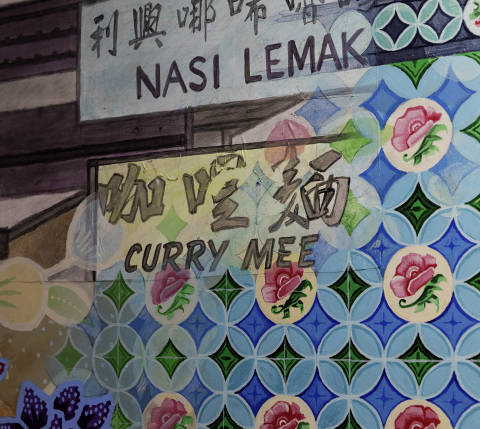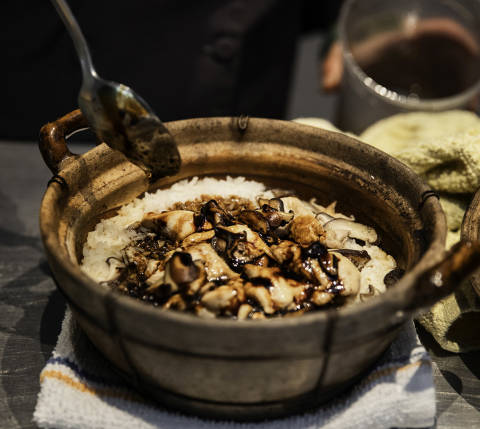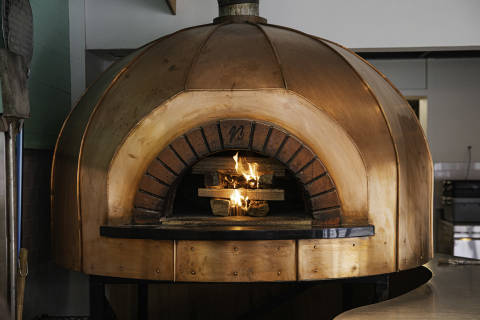On a drizzly Tuesday in mid-December, Ange Branca is tending to her pizza oven. The Malaysian chef has recently taken over the old Nomad Pizza space in Queen Village and is reinventing the two-story building as the home of Kampar, the new incarnation of Saté Kampar, her award-winning East Passyunk restaurant that closed in 2020. The pizza oven is huge, gleaming with copper and spitting flames.
"This oven is going to be perfect for Malaysian-style jungle cooking," she says, excited about what's in store. In a city chock full of Italian restaurants and pizza spots, Branca has a vision for something totally different. After years of setbacks, pivots, and explaining her food, she's on the precipice of sharing her grand vision of high-end Malaysian food, bar snacks, and mentorship with the city. But to understand what she's building, you have to go back to the beginning.

1. Saté Kampar (2016-2020)
Before there was Ange Branca the chef, there was Ange Branca the high-powered corporate consultant. She spent years working at Deloitte and IBM, thriving in a highly competitive, male-dominated field. Branca's biggest accomplishment from those years was her leadership on the development of the global supply chain networks that allowed IBM customers to order a computer online, have it custom built and shipped to their homes. These kinds of supply chains are standard now, but Branca was on the cutting edge of their creation.

"It's just how my brain works. I can look at a big problem and see the smaller strategies to solve it."
During her corporate career, Branca and her husband John regularly visited her home country of Malaysia. On those visits, they whiled away hours in kopitiams, the country's coffee shops, arriving early for a cup of teh tarik, a hot milk tea, lingering through the morning over kaya toast and a newspaper, then returning in the evening as vendors returned to serve beef rendang, nasi lemak, and other Malaysian classics. Soon Branca was imagining a new life, one where she traded in her corporate career for the world of food, and began running the numbers on how it would work to open a similar model in the United States.
"I told John, if we want to do something like this, we're gonna have to start with food to get our name out there," Branca remembers. They loved the idea of these larger restaurants that housed multiple concepts: not food halls, but also not restaurants in the way that Americans think of them. To eventually make it happen, she knew, they'd need to start with something more contained and build relationships and trust with diners and other cooks.

And so, in 2015, she left her corporate job and went full-in on conceiving of a restaurant for Philly. Saté Kampar was born the following year, opening in February of 2016 in a space on East Passyunk Avenue and specializing in saté, marinated meat skewers cooked over coconut charcoal briquettes imported from Malaysia. They served teh tarik and nasi lemak, a fragrant rice dish and Malaysian staple, both of which were largely unknown to the city at the time.
At first, they did a lot of explaining: of the food, of the menu, of the style of service. But the city fell in love and within a year the restaurant began racking up glowing reviews and accolades, including a 2017 nod from the James Beard foundation in the category of Best New Restaurant. Things were going well.
"When I started the restaurant, my guiding question was: 'How do we put Malaysian food in the spotlight,'" Branca recalls. Then, six months after opening, Trump got elected and Branca felt an urgency to shift that spotlight onto the broader community of immigrants in Philadelphia. She began hosting an event series to do just that, which she called the Muhibbah Dinners; in Malay, the word muhibbah means friendship while also gesturing at camaraderie and tolerance.
The first dinner featured dishes from a half-dozen chefs, including an undocumented person from Indonesia, who served fried tempeh, and Nicholas Elmi, a Top Chef winner and Philadelphia restaurant owner who created a plate of swordfish that paid homage to his Italian roots. The dinners raised money for nonprofits supporting the needs of immigrants and refugees in Philadelphia, and brought even more attention to Branca and her restaurant. They also connected Branca with an ever-expanding community of talented cooks who weren't getting the attention she felt they deserved.
2. Kampar Kitchen (2020-2023)
At the start of COVID, in the midst of shutdowns, Branca weathered the sudden upheaval by using her kitchen to cook meals for hospital workers and other communities in need. But when her lease ended in the spring of 2020, her landlord refused to budge on the rent increase baked into their contract, and Branca made the painful decision to close the restaurant.
"I was devastated," Branca remembers. "We intended to stay in that space long-term, and we invested a lot of our life savings in it. We were literally moving kitchen equipment to a storage facility, trying to salvage as much of our investment as we could."
Much like in her corporate days, though, the loss of the restaurant was a big problem to be solved by many smaller solutions. Her brain began ticking through options, breaking down her plan into smaller steps. Within a few months, Branca did a sold-out run at the outdoor space on top of the Bok Building, and took over the kitchen at a Center City bar for the summer. She was now serving Ramly burgers, a Malaysian double patty burger wrapped in a thin egg omelet, topped with cabbage, spicy mayonnaise and curry barbecue sauce. The dish caught on, selling out regularly as people got more comfortable with takeout and outdoor dining.

"We didn't have a home. But that question was still the same: 'How do we put underrepresented food in the spotlight?'"
In the middle of 2021, the answer she came up with was Kampar Kitchen, an idea grounded in the success of the Muhibbah Dinner Series. She'd seen the way guests got excited about eating food that spoke to the chef's personal history. Now, she'd harness that and deliver it to people's homes.
"I spent all this time when Saté first opened teaching people how to eat my food," Branca says. "I built a name for myself, people trusted me, and I wanted to use that trust to introduce them to these other chefs who were trying to build businesses."

"I built a name for myself, and people trusted me, and I wanted to use that trust to introduce them to these other pop-up chefs who were trying to build businesses."
She started with six chefs, whose food included everything from American soul food to vegetarian takes on Chilean classics. Each week, working out of commissary kitchens, they offered a takeout box that people could buy, filled with sweet and savory treats from the brains of these chefs. Branca herself was doing deliveries all over Philadelphia, bringing boxes to people who subscribed to Kampar Kitchen's offerings. At first it worked well, but as COVID restrictions dropped, commissary spaces became harder to come by.
"It started out daily, then went to weekly, then we went to once a month," Branca remembers. "Eventually we just couldn't do it anymore because no one had a place to cook."
As she pivoted and pivoted again, changing spaces and business models to keep up with the availability of kitchens and the demands of customers, Branca became increasingly sure that the only way to build something meaningful in the long term was to own a space. In 2021, she began working behind the scenes to secure funds to buy a building.

3. Kampar (2024-)
Today it is early 2024 and Branca, standing at the hearth of her new pizza oven in the soon-to-open Kampar, is closing in on her goal. She's spent three years working through the arduous process of securing an SBA loan, a government-backed program that helps small businesses get funding. It's been a long road, one that continues to challenge her persistence.
"If it's this hard for me to get one of these loans, it's nearly impossible for most immigrant business owners," Branca says. The loan still isn't finalized, but she's got a lease-to-own agreement on the two-story property, and hasn't given up.
Kampar is part pivot and part pirouette. The model is both a revival of what she loved about Saté Kampar and an evolution toward what she and John first imagined back in a different life on those early trips to Malaysia. In reference to the communal dining spaces of the kopitiams they frequented, she'll share the space with two other chefs who will join her for two-year residencies, during which time she'll mentor them and help build their business experience.
The downstairs space will host tasting menus: the resident chefs will each get two nights a week to host a solo tasting menu, and one night will be all Branca's food. Friday and Saturday nights they'll blow it out with a collaborative tasting menu — a nod, in ways, to her Muhibbah Dinners. These set menus will give chefs the opportunity to experiment, and Branca hopes the nights where they collaborate will foster creativity. The tasting menu model will also give these chefs an opportunity to serve their food on their own terms, rather than needing to explain themselves over and over, as she did during the early months of Saté Kampar.
Upstairs, a more casual restaurant and bar space will have an a la carte menu featuring classics from Saté Kampar and various pop-ups over the years: the Ramly burger, nasi lemak, beef rendang. Each of the chefs will also fill a few slots on the upstairs menu.
"We'll do saté…sometimes," Branca says with a laugh. "It's a lot of work to get all that meat on the sticks. I don't miss doing it."
The idea is that Kampar can be many things: a casual neighborhood bar with great food upstairs, and a high-end tasting menu downstairs. Hopefully, Branca says, people will fall in love with the casual food upstairs, which will encourage them to try the tasting menu at a higher price point. Start with the beer and a burger, expand from there.
Danny Childs, the former bar manager behind the local-ingredient-focused bar menu at The Farm and Fisherman is consulting to design a cocktail program with an eye toward drinks that pair well with the food.
"People have such preconceived notions about Malaysian drinks and wine that pair well with my food," Branca says. "People think of a Singapore Sling, or just pour Riesling. We're going beyond that."
Branca is particularly excited about highlighting Portuguese wines, a reference to the colonial history that brought Malaysian flavors to Europe in the 1400s.
"Their food has influenced our food in Malaysia," she explains, "And our spices have influenced Portuguese food for a long time. It only makes sense that since they are a winemaking country, that their wine would pair with the cuisine."

Branca is especially eager to point out the mural that covers one side of the upstairs dining room — an original that she and John salvaged from Saté Kampar space before they closed it in 2020. Up close, you can see the lines where they pulled it down, and there are some holes in the original work, but Jared Bader and Rashida Salam, the artists who created the mural, came back to the new space and painted colorful flowers and patterns to conceal some of the damage. What's there now is brighter, more colorful — and, fittingly, you can still see the original underneath.
Branca's magic is in that evolution. She has found a way to stay true to her original vision, even as cracks have formed and the specifics have evolved. When she looks back at the very first time she and John talked about running a food business over kaya toast in Malaysia, she's more focused on the things that haven't changed than she is on all that has. That focus, she says, is what made it all seem possible.
"I've always needed a goal to work towards, I always have a ten year plan," Branca says. "The route isn't exactly what I thought, but if you look at where we started, I'm right on time."
About Secret Menu
We created Secret Menu, a print and digital magazine from DoorDash, on the belief that one restaurant's story can help or inspire another. We're proud to elevate stories that connect local restaurant communities and celebrate the craft and ingenuity that makes them so vibrant here on the Merchant Blog. Read more Secret Menu stories here.





